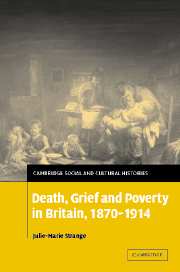Book contents
- Frontmatter
- Contents
- Acknowledgements
- List of abbreviations
- 1 Introduction: revisiting the Victorian and Edwardian celebration of death
- 2 Life, sickness and death
- 3 Caring for the corpse
- 4 The funeral
- 5 Only a pauper whom nobody owns: reassessing the pauper burial
- 6 Remembering the dead: the cemetery as a landscape for grief
- 7 Loss, memory and the management of feeling
- 8 Grieving for dead children
- 9 Epilogue: death, grief and the Great War
- Bibliography
- Index
1 - Introduction: revisiting the Victorian and Edwardian celebration of death
Published online by Cambridge University Press: 05 July 2009
- Frontmatter
- Contents
- Acknowledgements
- List of abbreviations
- 1 Introduction: revisiting the Victorian and Edwardian celebration of death
- 2 Life, sickness and death
- 3 Caring for the corpse
- 4 The funeral
- 5 Only a pauper whom nobody owns: reassessing the pauper burial
- 6 Remembering the dead: the cemetery as a landscape for grief
- 7 Loss, memory and the management of feeling
- 8 Grieving for dead children
- 9 Epilogue: death, grief and the Great War
- Bibliography
- Index
Summary
There's a grim one-horse hearse in a jolly round trot;
To the churchyard a pauper is going, I wot:
The road is rough, and the hearse has no springs,
And hark to the dirge that the sad driver sings:–
Rattle his bones over the stones;
He's only a pauper, whom nobody owns…
Poor pauper defunct! he has made some approach
To gentility, now that he's stretched in a coach;
He's taking a drive in his carriage at last,
But it will not be long if he goes on so fast!
Rattle his bones over the stones;
He's only a pauper, whom nobody owns…
But a truce to this strain! for my soul it is sad
To think that a heart in humanity clad
Should make, like the brutes, such a desolate end,
And depart from the light without leaving a friend.
Bear softly his bones over the stones,
Though a pauper, he's one whom his Maker yet owns.
(Thomas Noel, c. 1839)At length the day of the funeral, pious and truthful ceremony that it was, arrived… two mutes were at the house-door, looking as mournful as could be expected of men with such a thriving job in hand; the whole of Mr Mould's establishment were on duty within the house or without; feathers waved, horses snorted, silk and velvets fluttered; in a word, as Mr Mould emphatically said, ‘everything that money could do was done’.
(Charles Dickens, Martin Chuzzlewit, 1844)- Type
- Chapter
- Information
- Death, Grief and Poverty in Britain, 1870–1914 , pp. 1 - 26Publisher: Cambridge University PressPrint publication year: 2005



